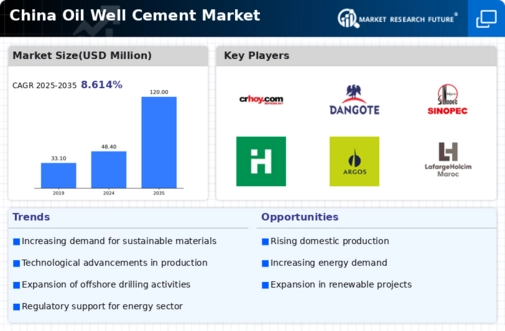Rising Demand for Energy
The increasing energy demand in China is a primary driver for the oil well-cement market. As the country continues to industrialize and urbanize, the need for energy sources, particularly oil and gas, escalates. This surge in energy demand necessitates the drilling of new wells, thereby driving the consumption of oil well-cement. In 2025, China's energy consumption is projected to grow by approximately 3.5%, which could lead to a corresponding increase in the oil well-cement market. The oil well-cement market must adapt to this growing demand by ensuring the availability of high-quality cement products that meet the specific requirements of drilling operations.
Technological Innovations in Drilling
Technological innovations in drilling techniques are reshaping the oil well-cement market. Advanced drilling technologies, such as horizontal drilling and hydraulic fracturing, require specialized cement formulations to ensure well integrity and performance. As these technologies gain traction in China, the oil well-cement market must adapt to meet the evolving needs of operators. The introduction of smart cement solutions, which can monitor well conditions in real-time, is expected to enhance the performance of cement in challenging environments. This shift towards innovation may lead to a projected growth rate of 4% in the oil well-cement market by 2026, indicating a robust demand for high-performance cement products.
Infrastructure Development Initiatives
China's ongoing infrastructure development initiatives significantly impact the oil well-cement market. The government's focus on enhancing transportation networks, energy facilities, and urban infrastructure creates a favorable environment for oil and gas exploration. As new infrastructure projects emerge, the demand for oil well-cement is likely to rise, as it is essential for the construction of drilling sites and related facilities. In 2025, investments in infrastructure are expected to reach over $1 trillion, which may lead to a substantial increase in the oil well-cement market. This trend suggests that companies involved in oil well-cement production should align their strategies with national development goals to capitalize on emerging opportunities.
Investment in Renewable Energy Sources
The increasing investment in renewable energy sources in China is indirectly affecting the oil well-cement market. As the country diversifies its energy portfolio, there is a concurrent need for oil and gas exploration to ensure energy security during the transition. This dual focus on renewables and traditional energy sources may lead to a balanced demand for oil well-cement. The oil well-cement market could experience growth as companies invest in both sectors, with projections indicating a potential increase in market size by 5% over the next five years. This scenario suggests that stakeholders should remain agile to adapt to the evolving energy landscape.
Environmental Regulations and Compliance
The tightening of environmental regulations in China is influencing the oil well-cement market. Stricter compliance requirements for emissions and waste management are prompting companies to seek eco-friendly cement solutions. The oil well-cement market is likely to see a shift towards sustainable practices, including the use of alternative materials and reduced carbon footprints in cement production. In 2025, it is anticipated that approximately 30% of cement used in oil well applications will be derived from sustainable sources. This trend indicates a growing awareness of environmental impacts and suggests that companies must innovate to meet regulatory standards while maintaining performance.

















Leave a Comment